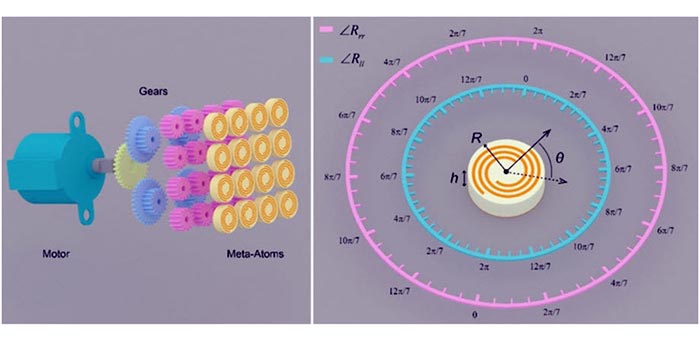
Mechanical Control Enhances Reconfigurable Intelligent Surfaces

Schematic views of the RIS supercell and the meta-atom. Right: Geometric phase control in each supercell is achieved by transmitting the torque from a stepping motor to the meta-atoms through a set of gears. Left: Pink and sky-blue dials schematically depict the geometric phase control resolution and variation gradients for different circular polarizations.
Credit: Xu et al., doi 10.1117/1.AP.4.1.016002.
A mechanically reconfigurable intelligent surface operates at microwave frequencies and uses a robust control method to determine the rotation angle of each meta-atom.
Reconfigurable intelligent surfaces (RISs) are a type of programmable structure that can be used to control the propagation of electromagnetic waves, by changing the electric and magnetic properties of the surface. They provide a new approach to improving the performance of wireless communications systems: change the propagation environment rather than adapting to it.
The integration of metallic resonators and electronic-driven elements, such as PIN diodes and varactor diodes, has advanced RIS research to a new stage. RISs can now manipulate electromagnetic waves with subwavelength resolution. Plus, in conjunction with a field-programmable gate array, these RISs can be switched dynamically among many different functions in real time, simply by changing the coding sequences.
Still, pain points persist in these diode-based RISs. First, the reconfiguration degree of freedom in the unit element scale is limited by the working principle of PIN/varactor diodes: most are binary and only a few can approach four. Also, the typical power dissipation of a single diode is around several hundred milliwatts; maintaining functionality requires a continuous power supply. Such energy consumption entails trade-offs between the size or number of unit element and the overall RIS size, hindering large-scale and long-term applications.
As reported in Advanced Photonics, an international team of researchers has developed a mechanical RIS that features a high reconfiguration degree of freedom, with low cost and low energy consumption. The RIS operates at microwave frequencies and uses a robust control method to determine the rotation angle of each meta-atom.
The RIS consists of a 20 × 20 supercell covering an area of 870 mm × 870 mm. Each supercell is composed of a stepping motor, a set of transmission gears, and a 4 × 4 array of meta-atoms. Each meta-atom can be mechanically rotated to achieve the desired phase control. This reprogrammable function enables a continuous and arbitrary phase control pattern over the entire RIS with high efficiency and uniform amplitude.
The researchers showcase dynamic and efficient control of the impinging wavefront on the RIS by reconfiguring its operation in real time across a number of functionalities. They demonstrate that the quasi-continuous phase tunability significantly improves the wavefront controllability.
The mechanically reprogrammable modules and meta-atoms can be flexibly attached/detached. Plus, the system maintains designated functionality without consuming electricity, so it offers a new energy-saving and environmentally friendly alternative. According to senior author Weili Zhang, professor of engineering at Oklahoma State University, “This RIS promises to achieve multidimensional manipulation of electromagnetic waves by incorporating different gear sets and different meta-atoms, which may bring RIS-related research to the next level.”
Read the open access article by Q. Xu et al, “Mechanically reprogrammable Pancharatnam-Berry metasurface for microwaves,” Adv. Photonics 4(1), 016002 (2022) doi 10.1117/1.AP.4.1.016002.
Journal: Advanced Photonics
DOI: 10.1117/1.AP.4.1.016002
Article Title: Mechanically reprogrammable Pancharatnam–Berry metasurface for microwaves
Article Publication Date: 1-Feb-2022
Media Contact
Daneet Steffens
SPIE–International Society for Optics and Photonics
daneets@spie.org
Office: 360-685-5478












